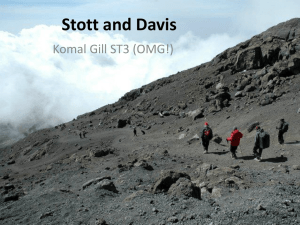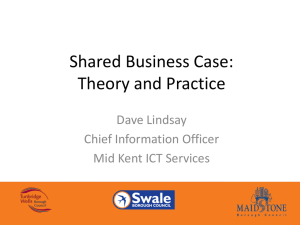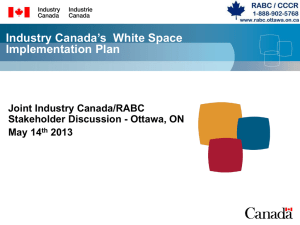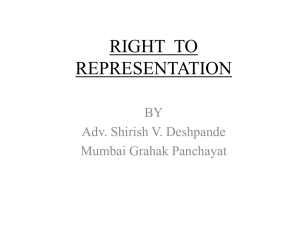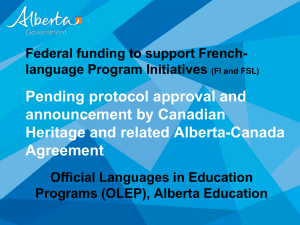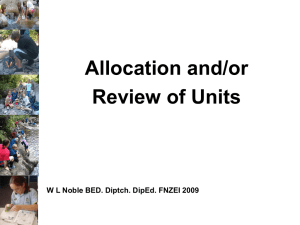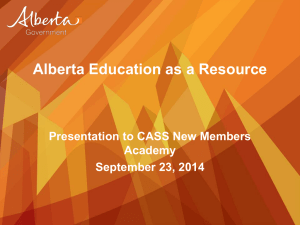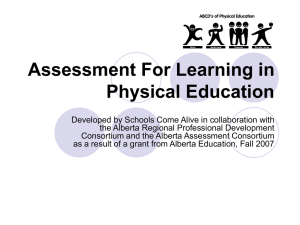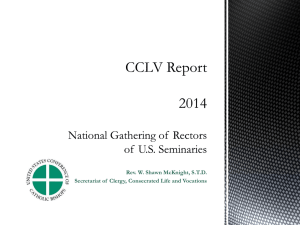Aboriginal Consultation Alberta`s Perspective
advertisement
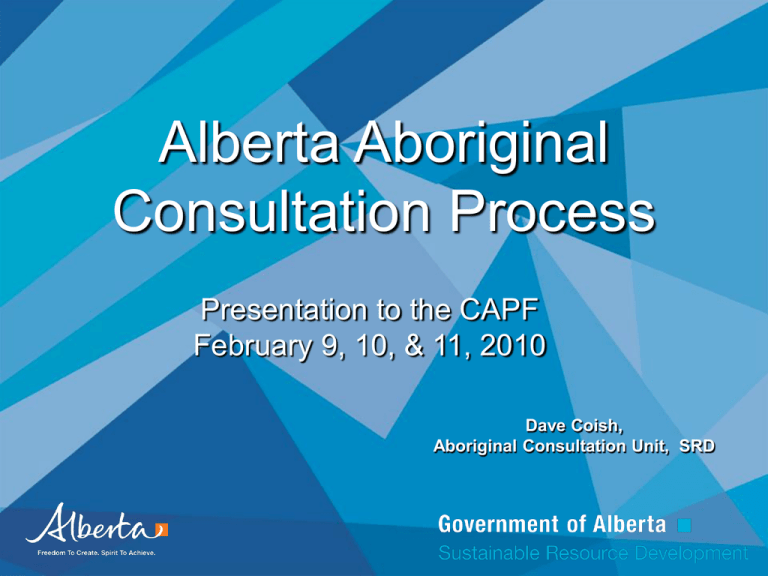
Alberta Aboriginal Consultation Process Presentation to the CAPF February 9, 10, & 11, 2010 Dave Coish, Aboriginal Consultation Unit, SRD Outline of Presentation History and general introduction to First Nations consultation in Alberta Guiding Principles Alberta’s duty and delegated consultation Role of the proponent Role of the Crown Key points Alberta’s Aboriginal Peoples Approx 170,000 people of First Nations ancestry live in Alberta Three Treaty areas (Treaties 6, 7 and 8). 47 First Nations, 8 Métis Settlements, Inuit, and off settlement Métis b. Constitutional Act, 1930 The Natural Resources Transfer Agreement (NRTA) BEFORE 1930 PUBLIC LAND IN ALBERTA WAS ADMINISTERED BY DOMINION OF CANADA 12. In order to secure to the Indians of the Province the continuance of the supply of game and fish for their support and subsistence, Canada agrees that the laws respecting game in force in the Province from time to time shall apply to the Indians within the boundaries thereof. provided, however, that the said Indians shall have the right, which the Province hereby assures to them, of hunting, trapping and fishing game and fish for food at all seasons of the year on all unoccupied Crown lands and on any other lands to which the said Indians may have a right of access. Section 35, Constitution Act, 1982 “THE EXISTING ABORIGNAL AND TREATY RIGHTS OF THE ABORIGINAL PEOPLES OF CANADA ARE HEREBY RECOGNIZED AND AFFIRMED.” Aboriginal Consultation Evolution through Case Law Three leading SCC Consultation Cases - Sparrow (Infringement) - Haida Nation & Taku River (asserted rights) - Mikisew Cree First Nation (taking up of lands) All three cases confirm Alberta’s obligation to consult where projects/decisions have the potential to adversely impact First Nations treaty rights Aboriginal Consultation Evolution through Case Law Sparrow Decision: The SCC - Defines what constitutes an infringement The SCC – Defines how an infringement can be justified Haida & Taku Decisions: The SCC - Obligation to consult arises; Scope & Objective of consultation; Delegation of aspects of consultation Mikisew Decision: The SCC: Defined the “taking up of lands” by the Crown; the threshold for consultation; Notice to First Nation Alberta’s Duty to Consult Alberta’s First Nations Consultation Policy (2005) and Guidelines (2006 & revised 2007) on Land Management and Resource Development are Alberta’s direction on how to implement the consultation process as defined by case law Two Aspects to the Consultation Process Legal Duty S. 35 Common law requirements – Honour of the Crown Potential to adversely impact Treaty Rights. Impacts to Treaty land Entitlements Good Governance / Policy Reasons Make informed decisions Improve and create working relations with those affected Risk management Consultation Process Alberta may carry out the duty to consult, or delegate certain procedural aspects of consultation to the project proponent Even when some aspects are delegated, Alberta remains fully engaged in the substantive aspects of consultation, and carries the legal liability for ensuring adequacy of consultation Delegated Consultation Aspects of Consultation Process Responsibility Determine if the proposed activity has the potential to adversely impact First Nations Treaty Rights or traditional uses Alberta Determine which First Nations should be consulted Alberta Present project to First Nations, record concerns, discuss modifications to project to address concerns Project Proponent Submit a consultation summary to Alberta with a copy to First Nation Project Proponent Review and judge adequacy of consultation as presented in the consultation summary Alberta Make decision regarding project approval, and advise project proponent and First Nations Alberta Role of the Proponent Provide a plain language description of the project including maps and contact information Identify potential adverse impacts to First Nations Treaty Rights & Traditional Uses Initiate meetings early in the process Role of the Proponent (cont’d) Develop strategies to avoid or mitigate identified potential adverse impacts Record all efforts at consultation including concerns brought forward and how these were addressed Submit a consultation summary to Alberta for adequacy review Role of the Crown (during the delegated aspects of consultation) To ensure the Proponent's consultation is consistent with the Policy and Guidelines To respond to questions from the Proponent and the First Nation To make recommendations to the Proponent's consultation plan, as necessary To provide assistance and direction when differences arise between the Proponent and the First Nation To determine the adequacy of the consultation at the end of the process Accommodation Consultation is about process, accommodation is about action – making changes to plans When accommodation is required, the Crown must balance aboriginal concerns reasonably with other societal interests (Haida, para. 50) Key Points Consultation with First Nations is required Alberta has the legal & policy responsibility for consultation The proponent meets with First Nations to listen to, and if possible, address concerns The proponent provides a consultation summary to Alberta Alberta judges adequacy of consultation and makes decision Questions? Dave Coish Phone: 780-644-8733 Email: Dave.Coish@gov.ab.ca
